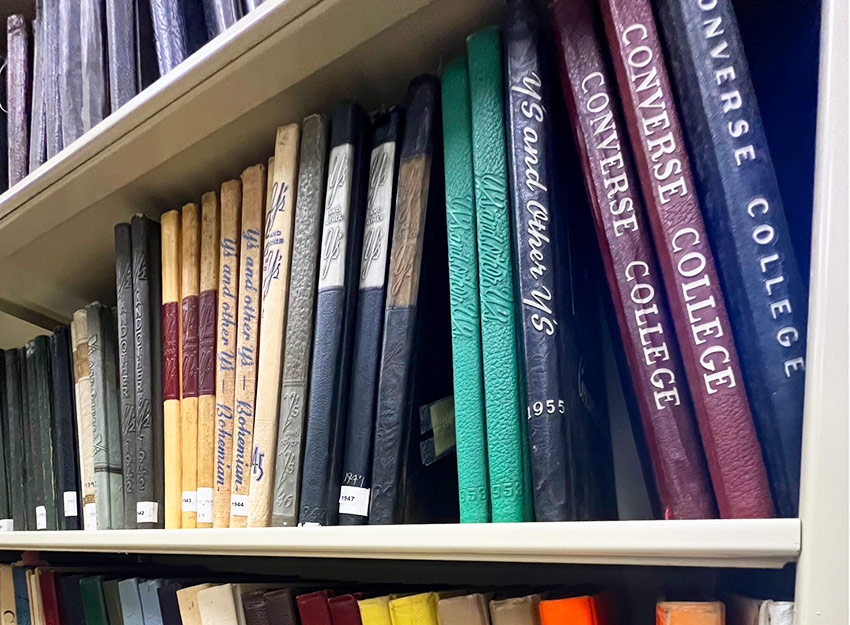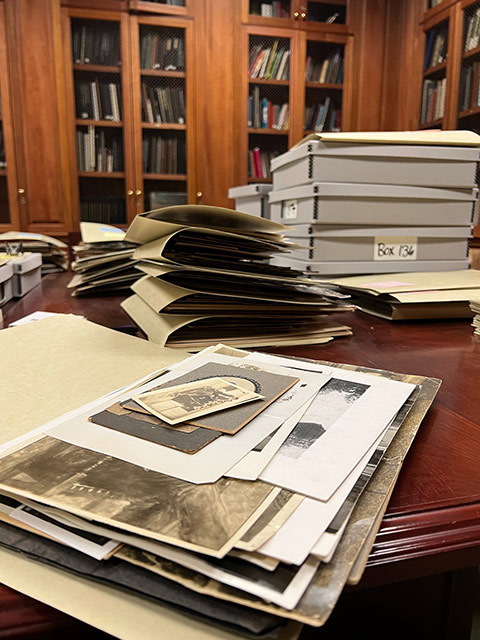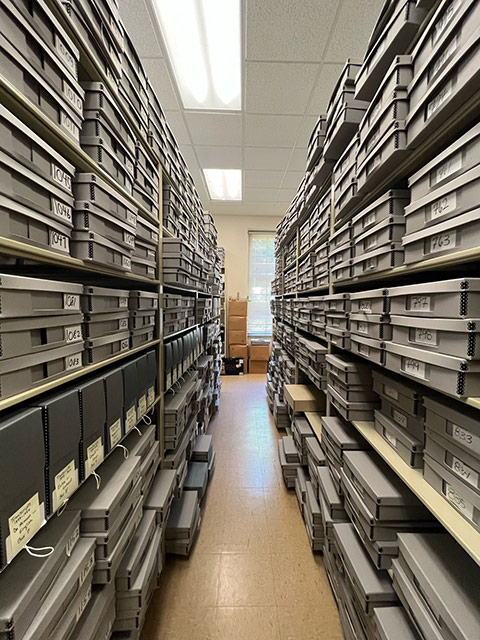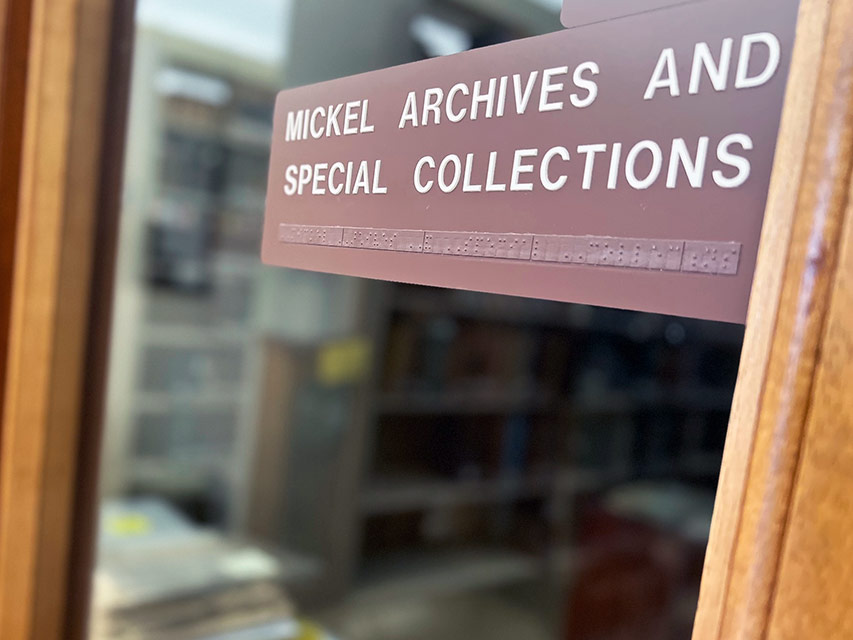Scanning the Past into the Present: Converse Yearbooks Digitized

By Azalea Acevedo ’21
It’s a sunny day like most others in the Upstate as Nancy Smith Gage ’82, Database Programmer for Campus Technology at Converse University, sits at her desk surrounded by office and Converse paraphernalia. A reminder of the school’s history is etched in the wall in the form of a wall stencil emblazoned with the year 1889 – a fitting callback to the topic of discussion.
“I remember her stature I think more than anything,” says Gage, recalling her six-foot tall great-grandmother, who graduated Converse in 1904. “That helps ‘cause when I’m looking at old pictures, she’s a little easier to spot,” says Gage, who is an alumna herself. In fact, her mother, grandmother, and many other women in her family are fellow alumnae.
Spotting your relatives in Converse pictures will now be a little easier, even if your grandmother is not tall, thanks to an archives digitization project made possible with a Growth Grant from South Carolina Humanities. With funding by the National Endowment for the Humanities (NEH) as part of the American Rescue Plan Act of 2021 and the NEH Sustaining the Humanities through the American Rescue Plan (SHARP) initiative, along with a partnership with the Spartanburg County Public Library, yearbooks and pictures from Converse’s early years to about the 1950s will be available for the first time online.
The Converse Archives is home to more than 100 years of university history and includes diplomas, class rings, photographs, transcripts, yearbooks, and other artifacts.
Tucked in the corner of the Mickel Library’s third floor sits the Converse Archives, home to over 100 years of university history. The collection includes diplomas, class rings, photographs, transcripts, yearbooks, and many other artifacts.
“We have the first diploma given by the school,” says archivist Rebecca Daniels. “Anything and everything gets sent up to my office. We’ve got collections of press releases, some old class rings, the oldest from 1910 I believe… student transcripts that go back to the beginning of the university, a collection of things that were donated by Alia Lawson when she retired, a whole collection of Lily Strickland compositions,” says Daniels, listing the variety of artifacts in her care.
Until now, however, the only way to see these items was to go to the archives, which have long been the destination for alumni and their families to rediscover or relive their Converse memories. Gage, who has previously worked in the alumni office, remembers directing those completing genealogical research to the previous archivist, the late Dr. Jeffrey Willis.
“Some people have a tidbit of information and they’re looking for more. And if they’re looking in general… then it’s a little harder,” says Gage.

“To be able to do that digitally means they don’t have to physically come to campus to look at a yearbook, so I think it opens up the doors for alumni nationwide and even around the globe,” says Gage.
This need for access became apparent during the COVID-19 pandemic when protective measures meant people could not come to campus or even leave their houses.
“I knew that Converse had recently lost its archivist, Jeff, and that was a big loss,” says Rebecca Parrish, speaking of the condition of the archives when she was hired in July 2021. As Director of Institutional Grants, she was responsible for the application to SC Humanities. “[Dr. Willis’ death] left our archives without support for about a year,” she says. At the same time, Rebecca Daniels was hired as the new archivist. The collection she inherited was, by nature, very old.
“You can already see the oldest books are falling apart, and we can do our best to preserve them as best we can for as long as we can but even the best types of preservation, it’s going to just completely disintegrate,” says Daniels. “To have things in a digital format will extend the history – the physical history of the school,” says Daniels.
Noticing a need to preserve the university’s oldest and most fragile artifacts before time destroys them, Daniels collaborated with Parrish to apply for funds for digitization. “We applied for funding for both equipment and for the ability to hire an intern over the summer to actually physically do the scanning work,” says Parrish. SC Humanities provides funds to institutions that enrich the cultural lives of those living in South Carolina.
“To have things in a digital format will extend the history – the physical history of the school.”
-Archivist Rebecca Daniels
The COVID Relief Grant to which Parrish and Daniels applied gave nearly $1 million in funds to help institutions “prevent, prepare for and respond to the pandemic,” says TJ Wallace, Assistant Director at SC Humanities.
Because the digitization project was both unique and involved opening access to the community, Converse’s application was one that interested SC Humanities, according to Wallace. The organization granted the project $8000 to scan over 50 years of yearbooks and index almost 100 years of photographs. With the support of SC Humanities, the project was able to forge ahead with the help of intern Britney Bogan, a sophomore.
Daniels and Bogan had a huge task ahead of them. Equipment of sufficient quality to scan the books for online use is expensive. While the scope of the project limited the years being digitized, the books and photos within that timeframe comprised around 1000 boxes. Plus, hosting the collection online requires even more resources.

“[Daniels] was amazing and she went to the Spartanburg County Public Library system… and we created an agreement where our intern would be able to use their high-quality Bookeye scanner,” says Parrish. The library also agreed to host the collection online, which they also do for other local organizations such as the hospital system and the Church of the Advent.
A community effort through and through, Daniels is hopeful that the project will strengthen ties within the Converse community as the institution creates a new path for the future. “It also will help past alumna to know that we’re not forgetting the school’s history. That this is where we came from, and these are our roots and we want to celebrate that and preserve it. But also know that everything changes” says Daniels.
While digitization has obvious benefits for those connected to Converse’s history, it also impacts current students. The project’s intern, Britney Bogan ’25, is a sophomore studying history. “I really enjoyed looking at photographs from 50 years ago, 100 years ago. Seeing different events on campus like events they had back then that they don’t have anymore, or events they had back then and still have now and have changed a little bit,” says Bogan.
For the 2022 student, accessing archival photographs is a look into how students used to live, and offers clues about the area’s history. For Bogan, it was especially surprising to find out Cudd Hall used to be a separate finishing school for girls.
The project also places current events into context.
“There were a lot of questions when Converse went coed a couple of years ago. If they look back at some yearbooks, they will see that there were men periodically in prior years… in the music school and other things,” says Gage.

As for Daniels, she hopes this is just the beginning for the archives. Many may not realize the archives are even there, as their location is tucked away and previously it had no contact page on the Mickel Library site.
“I would like to put the archive on people’s radar, make it a little more accessible,” says Daniels.
In digitizing the yearbooks, Daniels feels one step closer to this goal, but, like history, the archives are ever-evolving.
“You never run out of things to do and never run out of things to work on,” says Daniels with a laugh.
But the project to date has accomplished a lot, and, thanks to the partnership with SCPL, will continue to impact the Converse and Spartanburg communities.
“It will help with institutional advancement, it’ll help with recruiting new students as the years go on. If we can modernize our archives along with modernizing our brand it will lead us into this new era,” says Daniels.